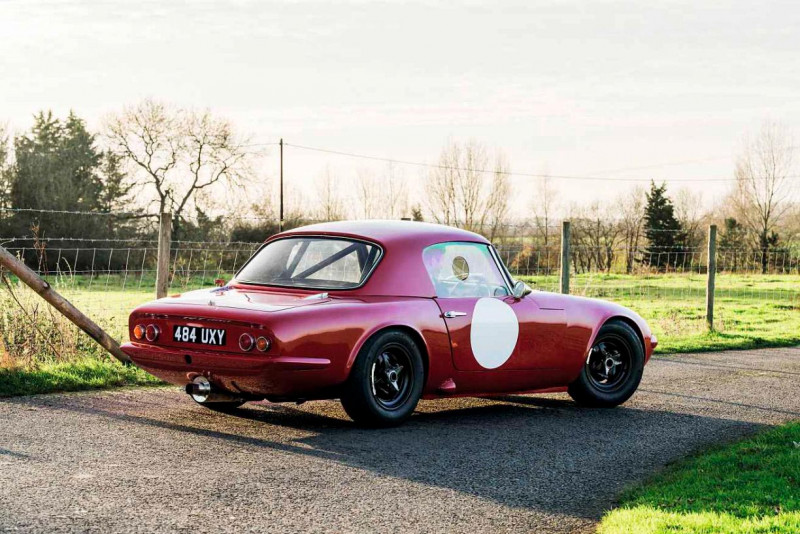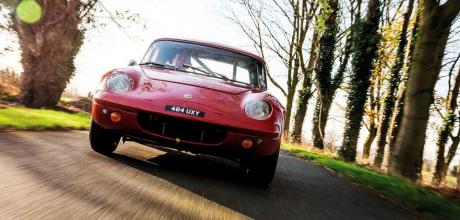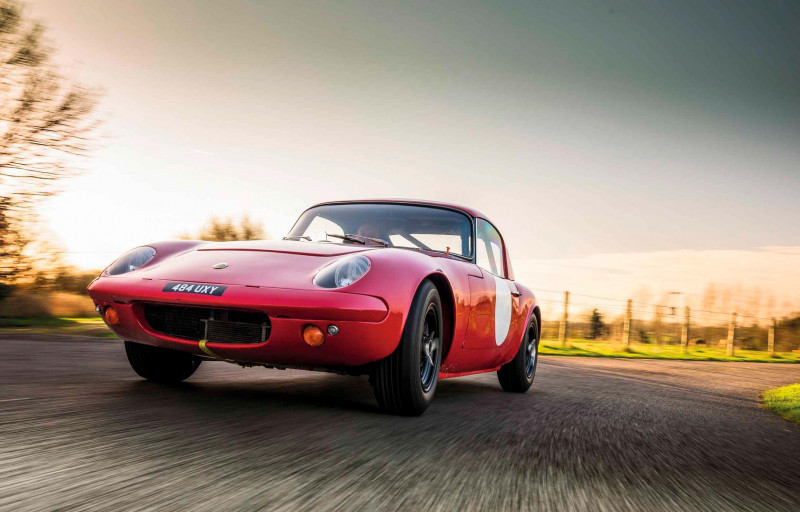1964 Lotus Elan 26R that kick-started Jackie Oliver’s career
As he heads into retirement, former F1 driver and team owner Jackie Oliver recalls the Lotus 26R that kick-started his stellar career. Words James Page. Photography Olgun Kordal.
Racer Jackie Oliver hangs up his boots by saying farewell to the Elan that started it all
LOTUS 26R
The Elan that kick-started Jackie Oliver’s career
There’s a poignant moment at the end of our day with Jackie Oliver when we walk up to the garage at his beautiful Buckinghamshire home. We venture inside to pick up a bag that had been left behind and there, alone in the corner, sits his Lotus Elan 26R. Recently sold and soon to be whisked away by its new owner, it’s quietly cooling down after its final outing in the hands of a man whose career it helped launch. Where once it had shared space with other significant cars from his time as a driver and a team owner, it’s now surrounded only by golf clubs and garden machinery. Oliver quietly admits that parting with it is going to be ‘a wrench’.
Over a cup of tea earlier in the day, we’d gone through his photo albums and reflected on the part played by the Elan in shaping Oliver’s future. It was in this car that his talent first caught the attention of Colin Chapman and Andrew Ferguson at Lotus, and set Oliver on a road that would lead to him winning the endurance classics at Le Mans, Daytona and Sebring, competing in 50 Grands Prix, claiming the 1974 Can-Am title, and setting an eye-opening 151mph lap record at LeMans in the Gulf-JWA Porsche 917.
‘NO-ONE WAS TRYING TO MAKE IT QUICKER ROUND CORNERS. THAT’S WHY THIS CAR WAS SO SUCCESSFUL’
In his early days, Oliver’s racing was bankrolled by his father, who had a business partner by the name of Ken Baker. Having bought an early Jaguar E-type, Baker then raced it – and with a reasonable amount of success, although Oliver soon demonstrated the difference between a quick amateur and a superstar in the making. ‘My father was into mobile refrigeration,’ he explains, ‘and Ken was into building bodies and trucks, so they amalgamated the businesses. Ken was a keen racer. He bought the E-type and started racing. Then they stuck me in the car and I was about five seconds quicker than him…’

The memories come flooding back as Oliver flicks through his albums. At one point, he stops at a couple of photographs showing a Ferrari in the paddock and the same car on track.
‘This is a meeting I went to at Brands Hatch and this is my father’s car. While he was in the coffee shop, they were saying if you want to do a timed one-lap sprint in the interval, you’re welcome to do that. You paid a fiver or something, so I used dad’s car. He came back and said, “Where’s my car?” Jackie’s got it. “Where is it?” It’s going round the track…’
The albums neatly chart Oliver’s progress From Mini to Marcos and Diva, before he went to his father and said that he needed an Elan. When that model had been launched in 1962, Colin Chapman had no intention for it to be a competition car. Official brochures described it as ‘a production high-performance luxury sports car’ and said that it was ‘not suitable for racing’. Inevitably, however, people soon started competing in the Elan, so during 1963 Ian Walker Racing and Graham Warner’s Chequered Flag outfit helped to develop it into a proper track weapon. Warner, in particular, was initially unimpressed with its circuit manners, noting that the backbone chassis would flex in extremis, and that the brakes and suspension weren’t really up to the job.
Many of his modifications would subsequently be adopted on Lotus’s official competition-spec Elan, the 26R, which was introduced in 1964. The chassis was strengthened, the ride height was lowered, springs and dampers were uprated, the suspension geometry could be adjusted, and the troublesome Rotoflex drive couplings were replaced with splined halfshafts. There were wider magnesium alloy wheels, too, plus Cosworth’s development of the 1558cc Twin Cam engine, which was good for peak power of just over 140bhp.
Development continued through Series 1 and Series 2 variants, with BRM-tuned engines being used in later cars. In total, 97 genuine 26Rs were built between 1964 and ’66, and campaigned by the likes of Jim Clark, Jackie Stewart, John Miles and Peter Arundell. Oliver remembers his father paying ¢G1800 for chassis number 26-S2-9.
‘Once we got it back home, my friend Barry, who was a bit of an engineer, started saying, “We’ve got to change this and change that. ”We played around with the springs and dampers. He was a great friend from that point of view, because everybody was experimenting in the 1960s with what you needed to do to make the car go quicker, but people were concentrating mostly on the engine. No-one was concentrating on the geometry, except the original designer. No-one was trying to make the car go quicker round the corners, and that’s why this car was so successful.’
Paddock photographs of the Oliver equipe show that it travelled in style: ‘I said, “Well, we’ve got to get a trailer.” Barry said, “Jackie, let’s build a transporter.” He said that we could buy something from the scrapyard and turn it into a transporter, so we went to a scrapyard and found this Ford. It was originally a baker’s van. I paid 100 quid for it and brought it back to the workshop, and it wasn’t long enough. We decided that we’d stretch it – but then the engine wasn’t big enough. OK – let’s put a bigger engine in it. There was a US airbase and next to it was a scrapyard with lots of American cars, so we bought a Ford Thunderbird. We extended the [truck] chassis, then fitted the engine, transmission and rear axle from the Thunderbird. It was unbelievable – Ford was so intrigued that there was an article about it in an in-house magazine called Challenge.’
With the Elan perched on its high-speed transporter, Oliver set off around the UK. In 1964, he had a great battle with Graham Warner in the Chequered Flag Elan en route to finishing fourth in the Scott Brown Memorial Trophy at Snetterton. The only people ahead of him were Roy Salvadori in a Ferrari 250 LM, Mike Salmon in an Aston Martin DB4 GT Zagato, and Tommy Hitchcock in a Cobra – rarefied company indeed. His success continued into 1965. In July, he finished second at Crystal Palace behind David Piper’s 250 LM, Autosport commenting: ‘Jack Oliver rushed his little Elan around to claim a fine second overall and a class win and he, too, collected a new [lap] record for his efforts.’
He also started to venture further afield. In September, Oliver travelled to Montlhery for the Coupes de Paris meeting and won the small-capacity sports car and GT contest. Autosport again: ‘Jack Oliver had an easy win with the Expert Engineering-tuned Elan, completely outpacing Bernard Consten, who was driving a GTZ Alfa from Autodelta, specially brought over for the race.’
His success wasn’t going unnoticed: ‘We kept on beating the works cars, and the more times I beat them, the more keen Colin [Chapman] was to sign me up. I ended up driving for the Formula 3 team because of this car – they signed me up with a three-year contract. My father had bought me a Brabham Formula 3 car. I did Goodwood and Snetterton [in 1966], and then Colin said, “Stop that – I want you to drive a Formula 3 car with Charles Lucas Team Lotus.” It was a three-car team with Piers Courage and Roy Pike, and that was the start of it – and all because of the Elan.’
Oliver moved up to Formula 2 in 1967 and then, in April 1968, Lotus and Chapman were devastated by the death of Jim Clark. Oliver found himself being promoted to the Formula 1 team in the most tragic of circumstances, and even if it would be a challenging year – he left at the end of it to join BRM – his time at Lotus left a lasting impression.
‘Everything I’ve done in life, I’ve thought, “What would Colin have done in this situation?”, particularly when I started my own team. That’s how big the effect was. He was all things to all people. He could find the money, he could even drive the cars, and he was certainly the best guy in that period to lead the design office. I spent most of my life at Hethel.
‘The problem with Colin was that he lost his best mate and his best driver, and I was a poor replacement. And what he wanted was a driver who could tell him what they needed to do to the car. I wasn’t that person. I knew what I needed to do to the car, but I was too enamoured with him. I kept calling him “Sir”. That was a mistake. Colin was looking for a driver who would dominate the situation, and he would then take the information he needed and use his skill to produce a successful car.
‘I realised that when I fell out with [Louis] Stanley. I went to BRM thinking that what I should do is be much more forceful, not realising that Stanley didn’t want that…’ Oliver’s driving career wound down during the 1970s, and he formed Arrows in late 1977. The years he spent keeping that team afloat in the Formula 1 ‘Piranha Club’ are another story entirely, but eventually he sold up to Tom Walkinshaw and found himself being tempted into Historic racing by Charles March.
‘Charlie said to me, “Why don’t you do the Revival?” because I used to drive cars up the hill [at the Festival of Speed]. I told him that I’d stopped doing it 20 years ago, and that I didn’t even have a licence. He said it’d be easy to get a licence again, and found a very nice guy with a 1950s Porsche. I did the race and Charlie said to me, “There you go – that was alright, wasn’t it? Do you want to do it again?” I asked if I could have something with a bigger engine.
I didn’t like being at the back of the grid.’ With his competitive juices reignited, Oliver embarked on what became a busy schedule that would involve him racing everything from a BMW TiSA and Ferrari 250 GT Short Wheelbase to a Chevron B16 and even Ken Baker’s old E-type. Then a friend told Oliver that he knew where the Elan was, and asked if he’d be interested. He was, and having bought it back he entered it for the Fordwater Trophy at the 2012 Goodwood Revival, finishing second to Martin Stretton in the ‘Goldbug’ Ian Walker Racing Elan Coup…
Octane has ‘previous’ with Oliver’s 26R, having driven it a few months before that Goodwood outing when it was owned by Michael Schryver. Inside, there is nothing in the way of trim, the workings of the glassfibre body being fully exposed – including the mild steel frame that supports the door surrounds. Everything is pared right back, to the point that the Perspex windows look thin enough to fold out of the way.
Whereas a standard Elan is all about delicacy and balance, the 26R has a much more direct sense of urgency. It’s a car that invites you to wring its neck, the familiar throaty gurgle of a Twin Cam hardening as the revs rise, and it responds instantly to every input. Little wonder that, in period, a 26R driven by a real ace was perfectly capable of humbling far more exotic machinery.
With Oliver kept busy racing other people’s cars, opportunities to use the Elan were few and far between. Also, his thoughts have turned once again to hanging up his helmet – although you sense that perhaps those around him are keener for that to happen than them an himself. Hence the decision to sell, and the Lotus will at least be going to a good home, new owner Flemming Viktor Andersen having previously raced a 26R-spec example. Coincidentally, he hails from the same city in Denmark – Aarhus – as Oliver’s wife Dorthe.
And even though it’s sad for Oliver to be saying goodbye to the Elan, to be honest it doesn’t really matter whether or not it’s actually in his garage. It will always be his car.
‘EVERYTHING I’VE DONE IN LIFE, I’VE THOUGHT: WHAT WOULD COLIN HAVE DONE IN THAT SITUATION?’
THANKS TO Jarrah Venables, jarrahvenables.com, and Duncan Hamilton ROFGO, dhrofgo.com.
Above and right Jackie Oliver is ready to hang up his helmet; the Elan that changed his life has already moved on. Clockwise, from below left Cosworth-tuned Lotus Twin Cam was good for 140bhp in period; bare interior features little beyond necessary dials and minimal switchgear; recognisably an Elan though less cute.

Opposite, clockwise, from top left Oliver goes through his photo albums with James Page; Thunderbird-engined transporter at Silverstone; fourth overall and a class win in the ’64 Scott Brown Memorial Trophy at Snetterton (Mike Salmon’s Aston Zagato is just beyond); in 26R on way to winning the 1965 Montlhéry Coupe de Paris.
TECHNICAL DATA 1964 Lotus Elan 26R
- Engine 1558cc DOHC four-cylinder, two Weber DCOE carburettors
- Peak power 144bhp @ 7800rpm
- Peak torque 102lb ft @ 4300rpm
- Transmission Four-speed manual, rear-wheel drive
- Steering Rack and pinion
- Suspension Front: double wishbones, coil springs, telescopic dampers, anti-roll bar. Rear: half-shafts with lateral links, coil springs, telescopic dampers, anti-roll bar
- Brakes Discs
- Weight 576kg




I used to own 26-s2-09 in the mid to late 1970s.
Jim Z